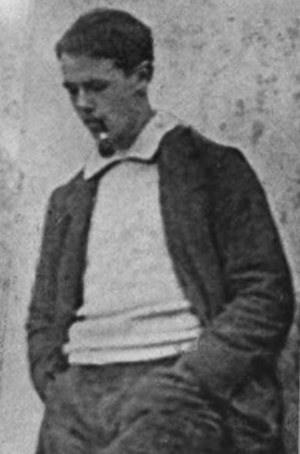Siegfried Herford facts for kids
Quick facts for kids
Siegfried Herford
|
|
|---|---|
 |
|
| Born |
Siegfried Wedgwood Herford
1891 England
|
| Died | (aged 24) France
|
| Cause of death | Killed in action |
| Occupation | Student Mountain climber |
| Parent(s) |
|
| Military career | |
| Allegiance | |
| Service/ |
|
| Rank | Private |
| Unit | Royal Fusiliers |
| Battles/wars | World War I |
Siegfried Wedgwood Herford (born 1891 – died 28 January 1916) was a British mountain climber. He was very active in the years just before World War I. Siegfried, along with John Laycock and Stanley Jeffcoat, helped start a new style of climbing in England. This style, called "gritstone climbing," involved climbing on large rocks called bouldering. They also used ropes to climb up the sides of cliffs.
Early Life and Studies
Siegfried Herford was born in England in 1891. His father, C. H. Herford, was a professor. As a child, Siegfried was sometimes very quiet. Other times, he had bursts of energy. He was also very good at math.
In 1909, Siegfried started studying engineering at the University of Manchester. He began rock climbing around this time. By 1911, he had created a new climbing move called the "girdle traverse." He first tried it out at Castle Naze in the Peak District. Later, he used this idea on the large rock face of Scafell.
Even though Siegfried spent a lot of time climbing, he was also an excellent student. He was top of his class in math and physics when he graduated in 1912. After that, he received a special scholarship. This allowed him to do research on airplanes at the Royal Aircraft Factory in Farnborough.
Amazing Climbing Feats
In the spring of 1914, Siegfried Herford and three friends climbed the Central Buttress of Scafell. This was a very difficult climb. They found a way to get past the hardest part, called the Flake Pitch. They looked at the climb from both above and below to plan their route.
Siegfried believed in "downclimbing," which means climbing down a rock face. He even wrote an article about it called "The Doctrine of Descent." It was published in the 1913 Fell & Rock Climbing Club Journal.
His climb on Scafell was a big achievement in British rock climbing. It was rated HVS, which is a very challenging climb (5.9).
Joining the War
When World War I began, Siegfried wanted to join the army as an officer. However, because his family had some German background, he was not given an officer position. Instead, he joined the Royal Fusiliers as a private soldier.
Sadly, Siegfried Herford was killed during the war. He died on 28 January 1916, from a grenade explosion.

